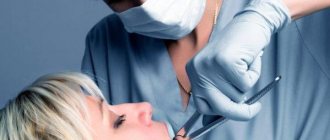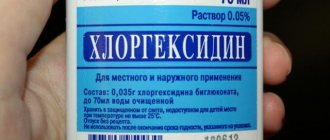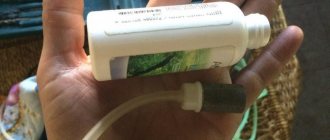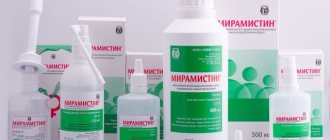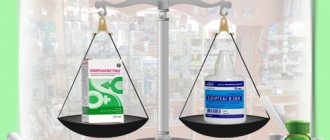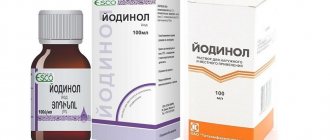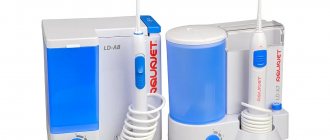Chlorhexidine belongs to the group of broad-spectrum antiseptic and bactericidal drugs for external and local use. It is based on the substance bigluconate, as well as purified water or alcohol. The solution is available on the market in different concentrations. In this article we look in more detail at what chlorhexidine solution is and where it is used.
Where is Chlorhexidine used?
The pharmaceutical product is used for the treatment and prevention of diseases caused by microorganisms sensitive to Chlorhexidine.
Depending on the concentration of the substance, the medicine can be used in the treatment of various pathologies.
After operations, in order to prevent infectious pathologies, doctors resort to using a pharmaceutical solution.
Chlorhexidine is often used for dental purposes for the treatment of dentures. In some cases, medication is used to treat periodontitis, stomatitis, and they are used to rinse the gums.
The medicine is used in:
- Urology
- Gynecology
- Surgery
Possibility of using solutions
Pharmacies offer chlorhexidine bigluconate in aqueous solutions with a concentration of: 0.05%; 0.1%; 5% and 20%. Preparations 0.05 and 0.1% are ready for use and therefore this chlorhexidine can be used for preventive and therapeutic purposes without any special measures.
Compositions of 5 and 20 percent concentration require careful handling and must be diluted for further use.
In cases where the product is planned to be used for medical purposes, distilled water is used to dilute it, and the use of the solution in everyday life does not exclude the use of ordinary boiled water. However, it should be borne in mind that so-called “hard” water helps to reduce the bactericidal properties of chlorhexidine.
In addition, the drug is pharmaceutically incompatible with soap and other alkaline compounds, and the inclusion of ethanol enhances the effectiveness of the product, which implies the use of alcohol solutions for treatment:
- surgical field;
- hands;
- sterilization of surgical instruments.
The range of action of the drug, for example: the ability to resist both gram-positive and gram-negative microorganisms, allows us to consider chlorhexidine as an essential drug. Therefore, such compositions should be present in both the home and car or camping first aid kits.
For medical purposes, solutions offered over the counter, in particular chlorheskidine bigluconate 0.05%, are successfully used by dentists and otolaryngologists. A concentration of 0.05% suggests the use of a mouth and throat rinse. However, to prevent and treat diseases in children, experts recommend the use of drugs produced in the form of sprays.
Chlorgesidine bigluconate: use in dental practice and in the treatment of throat diseases
The drug chlorhesidine at a concentration of 0.05%, in addition to its high antiseptic effectiveness, has the unique ability to form a special protective film, which allows you to prolong the therapeutic effect of the product if it gets on the mucous membranes during procedures. Thus, the drug affects pathogenic bacteria not only during the rinsing process, but also for several hours after its completion.
A sufficiently high content of active substances over a long period of time helps the successful use of these compositions for treatment and prevention:
- gingivitis;
- periodontitis;
- stomatitis;
- inflammation of the socket of an extracted tooth;
- inflammation during the eruption of wisdom teeth;
- throat infections,
It is also recommended by specialists for the disinfection of dentures.
In addition, chlorgesidine, the instructions for use of which include the main indications for the use of the drug, is recommended by specialists after tooth extraction operations, for example, in cases of:
- when the operation was performed accompanied by inflammatory processes;
- during complex surgical interventions;
- if there are carious areas or hard deposits left in the oral cavity that can infect the wound and lead to suppuration of blood clots.
For alviolitis, chlorgesidine is prescribed as an additional prophylactic agent, not being a drug for the treatment of the disease. Therefore, if a blood clot disintegrates, self-medication is excluded and the help of a dentist who is able to provide professional treatment is required.
The process of eruption of wisdom teeth can often provoke the occurrence of inflammation, as it is accompanied by the appearance of areas of the mucous membrane lying on the chewing surface. When eating food, its particles can get into “pockets” between the surface of the mucous membrane and the tooth, which provokes the proliferation of bacteria and the occurrence of infections.
In addition, the inflammatory process is often accompanied by swelling of the mucous membrane, the release of purulent masses and other manifestations, which is the reason for using the drug. However, quite often, treatment cannot be limited to rinsing and specialist intervention is necessary.
Chlorgesidine bigluconate
, the use of which is recommended by dentists for many diseases of the oral cavity, is able to effectively cope with purulent infections, for example, those that arise when opening purulent abscesses. Using the drug will help protect the mucous membranes and tonsils from the spread of pathogenic microorganisms.
Chlorhexidine
– an effective remedy for combating gum inflammation, which can be caused by hard dental deposits and microbial plaque. The use of the drug will speed up the recovery of the oral cavity, but first, the factors contributing to the disease must be eliminated.
In addition, chlorhesidine bigluconate is successfully used in the treatment of throat diseases and as a prophylactic agent to protect the oral cavity from stomatitis.
Chlorgesidine
, the instructions for use of which allow you to use the product without a doctor's prescription, can cause disinfection of the oral cavity, therefore it is recommended to limit the course of use of the drug to 10-12 days. However, if it is necessary to continue disinfecting rinses, you should switch to products that contain florides and plant extracts.
In addition, in the treatment of dental diseases, chlorgesidine, in most cases, is only an auxiliary agent, since, being an effective antiseptic, it does not have the necessary therapeutic effect.
Contraindications
Chlorhexidine is contraindicated:
- In case of hypersensitivity to the components of the drug
- People suffering from dermatitis
- Do not use together with other antiseptics, for example, with hydrogen peroxide
- For ophthalmic use, rinsing the eyes with this product is prohibited.
- For disinfection of the surgical field
- After intervention on the auditory canal and central nervous system
It is important to know that the pharmaceutical product should be used with caution when treating children.
Possible side effects
As with any other drug, the use of chlorhexidine is fraught with side effects. People sensitive to the drug may experience allergic reactions.
Sometimes the effect of a solution or gel is manifested by photosensitivity - sensitivity of the skin and mucous membranes to ultraviolet radiation.
Rinsing with a solution is fraught with a change in the color of tooth enamel, the deposition of tartar, and the taste may also be affected.
sells antiseptics with chlorhexidine. We supply certified goods of our own production in bulk, guarantee quality and competitive prices, and organize delivery.
Brief instructions for use
To prevent sexually transmitted diseases, after unprotected sexual intercourse, after a maximum of 2 hours, 2-3 ml of a 0.5% solution should be administered into the urinary canal of a man, 1 ml into the canal for women and 5-10 ml into the vagina. You can treat skin areas near the genitals with the product. After administering the drug, try to postpone urination for 2 hours.
Your doctor should tell you about douching for gynecological diseases.
For sore throat, rinse the mouth with 0.5% or 0.2% Chlorohexidine solution.
For inflammatory pathologies of the urinary tract, it is necessary to inject 2-3 ml of 0.05% of the product into the urinary canal.
Before using the drug, you should consult your doctor.
Chlorhexidine and coronavirus
It has been proven that alcohol-based antiseptics are effective against coronavirus, and its content should be at least 60%, but preferably more. Therefore, chlorhexidine in an aqueous solution effectively copes with bacteria, but not with viruses.
But, as we said above, chlorhexidine is also made with alcohol, which makes this antiseptic effective in the fight against COVID 19. To do this, you can purchase an alcohol solution of chlorhexidine with a concentration of 0.5% at the pharmacy. Another option: take a 20% aqueous solution of the substance and a 70% alcohol-containing liquid and mix these two components in a ratio of 1 to 40. You need to treat your hands with the composition according to this principle:
- First, wash your hands with soap for 15 seconds.
- Then rub in the alcohol solution of chlorhexidine for 2 minutes.
- The amount of liquid rubbed in should be approximately 5 ml.
But you can wipe surfaces with aqueous solutions; with prolonged contact with the pathogen, most of the virus will still be destroyed.
Often, antiseptics with chlorhexidine are produced in the form of a gel containing alcohol and depanthenol, which moisturizes the skin.
Where to put candles
Depending on the type of disease, the method of administering Chlorhexidine suppositories can be different: rectal or vaginal.
But it is important to understand that the use of suppositories is only permissible as prescribed by a doctor.
Before using the suppository, you need to wash and dry your hands well, then you need to remove it from the package and insert it into the vagina in a lying position.
To avoid leakage of the drug, do not rush to get out of bed.
Chlorhexidine suppositories help well with thrush and cystitis.
Chemical properties
To better understand what chlorhexidine is, you need to know its chemical properties. It appears to be a white crystalline powder and has a melting point of 137 °C. To make the drug, the powder is diluted in a certain proportion with water or alcohol. The resulting solution is colorless or light yellow.
It has a weak, unexpressed odor or is characterized by its complete absence. The chemical formula is C22H30CL2N10. It is stable, which makes it possible to achieve a normal bactericidal effect when applied to the skin, when rinsing, etc. When mixed with alcohol, the bactericidal and antiviral characteristics of the substance are enhanced.
Why is Chlorhexidine better than peroxide?
- Hydrogen peroxide and Chlorhexidine are antiseptics. Medicines differ in their spectrum of effects and medicinal properties.
- Hydrogen peroxide, unlike Chlorhexidine, is available in only one dosage form, which is not very convenient.
Chlorkesidine suppositories are used for the treatment of gynecological and urological pathologies.
Both products disinfect wounds and abrasions well.
Chlorhexidine has a wider range of therapeutic effects; it is used to treat the hands of the surgeon and nurse before surgery, and it is also used in gynecology.
Dangers of using chlorhexidine mouthwash
You should not uncontrollably use chlorhexidine solution to rinse your gums and teeth; this can lead to a number of problems.
- Chlorhexidine affects not only pathogens, but also the natural flora of the oral cavity, which can ultimately lead to imbalances in the microflora. Uncontrolled use of an antiseptic has an effect on both good microbes and bad ones, but after stopping use, the bad microbes grow faster than the good ones.
- Constant use of an antiseptic can cause microflora resistance. According to recent studies, chlorhexidine causes resistance to antibiotics when they are really needed.
- Due to regular use of chlorhexidine for rinsing, intense dark plaque may appear on the teeth and tongue. This problem will have to be solved in the dentist's chair. This solution should be used only after consultation with a doctor and only for a limited period. This also applies to various toothpastes and rinses that contain it.
Book an appointment with a periodontist now by clicking the “Plus” button on the right side of your screen.
To the list of posts
Use of the drug during pregnancy and lactation
Pregnancy, as well as breastfeeding a baby, is not a contraindication to the use of the drug.
Using the product to treat wounds is acceptable, but with caution. The drug has no toxicity and does not have a systemic effect. When treating damaged areas of skin, only a small part of the product can penetrate the bloodstream without creating a threat to the developing baby.
The drug does not cause any adverse reactions, so theoretically its use for external treatment of skin lesions cannot cause any harm to the unborn baby. Rather, on the contrary, an infection that penetrates a wound can enter the bloodstream through damaged blood vessels, and through it to other organs. The development of an infection anywhere inside the body will lead to an inflammatory process and the occurrence of diseases that will affect the development of the baby.
Therefore, the use of the drug for treating wounds during the period of bearing and feeding a baby is more than justified, but caution in use will not hurt.
What is hydrogen peroxide
The chemical hydrogen peroxide is considered one of the most effective disinfectants. The effectiveness of peroxide is even greater when used in concentrated form. Available in the pharmaceutical network in a concentration of 3-10%.
The starting substance is very powerful, and the chemical composition is quite simple - a water molecule made of hydrogen and oxygen with an additional oxygen atom. The substance is colorless and odorless. Due to the intermediate formation of atomic oxygen, it is a very good oxidizing agent, which is used in the laboratory in the form of aqueous solutions in various concentrations.
It is used not only in medicine, but also for household and cosmetic purposes, decomposing after a reaction into simple substances - water and oxygen.
Douching with a solution: indications for use
In the field of gynecology, the presented solution is used in irrigation for the following indications:
- Colitis and candida.
- In the diagnosis of sexually transmitted infections, these are chlamydia and trichomonia, ureplasmosis and gonorrhea, syphilis and genital herpes.
- Application of the solution and course of sanitation of the genital tract before / after diagnostic procedures.
- To prevent sexually transmitted infections during unprotected sexual intercourse.
- For the treatment of genital organs before/after surgery.
- Diagnosis includes vulvovaginitis and bacterial vaginosis.
Treatment of wounds in children
Children of different ages very often receive all kinds of injuries and wounds. Kids are very actively exploring a new world for them, and in the process of getting to know it, they do not do without abrasions.
Children learn to rollerblade and bicycle, play outdoor games, climb trees, swing on swings, play various sports, communicate with animals, and quite often they get various injuries that require antibacterial treatment in order to prevent the penetration of harmful microorganisms and spread infections.
Since Chlorhexidine does not have a toxic effect on the body, does not cause adverse reactions or allergic manifestations, it can also be used to treat wounds, abrasions and other skin lesions even in very young children.
